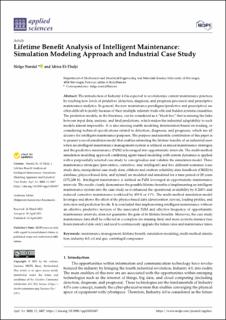| dc.description.abstract | The introduction of Industry 4.0 is expected to revolutionize current maintenance practices by reaching new levels of predictive (detection, diagnosis, and prognosis processes) and prescriptive maintenance analytics. In general, the new maintenance paradigms (predictive and prescriptive) are often difficult to justify because of their multiple inherent trade-offs and hidden systems causalities. The prediction models, in the literature, can be considered as a “black box” that is missing the links between input data, analysis, and final predictions, which makes the industrial adaptability to such models almost impossible. It is also missing enable modeling deterioration based on loading, or considering technical specifications related to detection, diagnosis, and prognosis, which are all decisive for intelligent maintenance purposes. The purpose and scientific contribution of this paper is to present a novel simulation model that enables estimating the lifetime benefits of an industrial asset when an intelligent maintenance management system is utilized as mixed maintenance strategies and the predictive maintenance (PdM) is leveraged into opportunistic intervals. The multi-method simulation modeling approach combining agent-based modeling with system dynamics is applied with a purposefully selected case study to conceptualize and validate the simulation model. Three maintenance strategies (preventive, corrective, and intelligent) and five different scenarios (case study data, manipulated case study data, offshore and onshore reliability data handbook (OREDA) database, physics-based data, and hybrid) are modeled and simulated for a time period of 20 years (175,200 h). Intelligent maintenance is defined as PdM leveraged in opportunistic maintenance intervals. The results clearly demonstrate the possible lifetime benefits of implementing an intelligent maintenance system into the case study as it enhanced the operational availability by 0.268% and reduced corrective maintenance workload by 459 h or 11%. The multi-method simulation model leverages and shows the effect of the physics-based data (deterioration curves), loading profiles, and detection and prediction levels. It is concluded that implementing intelligent maintenance without an effective predictive horizon of the associated PdM and effective frequency of opportunistic maintenance intervals, does not guarantee the gain of its lifetime benefits. Moreover, the case study maintenance data shall be collected in a complete (no missing data) and more accurate manner (use hours instead of date only) and used to continuously upgrade the failure rates and maintenance times. | en_US |

